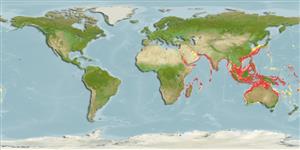Common names from other countries
Environment: milieu / climate zone / depth range / distribution range
Ecologia
marinhas; estuarina demersal; intervalo de profundidade 10 - 400 m (Ref. 11441). Tropical; 26°C - 29°C (Ref. 4959)
Indo-West Pacific: Persian Gulf (Ref. 11441), off Pakistan, the west coast of India and Sri Lanka, Indonesia, the Philippines, Japan, and the north and east coasts of Australia.
Tamanho / Peso / Idade
Maturity: Lm ? range ? - ? cm
Max length : 44.0 cm SL macho/indeterminado; (Ref. 559); common length : 30.0 cm TL macho/indeterminado; (Ref. 2872); peso máx. publicado: 61.90 g (Ref. 124479)
Espinhos dorsais (total) : 0; Raios dorsais (total) : 107 - 113; Espinhos anais: 0; Raios anais : 80 - 88. Eyed side brown with an irregular dark blotch on gill cover, blind side white. Blind side with 2 lateral lines (dorsal and medial). Body elongate, its depth 22 to 29% SL. Eyes with a small scaly interorbital space. Snout rounded. Rostral hook short. Corner of mouth reaching posteriorly beyond lower eye, nearer to gill opening than to tip of snout. Caudal-fin rays usually 12. Midlateral-line scales 88 to 96. Scales ctenoid on eyed side of body. Cycloid on blind side. Scale rows between lateral lines on eyed side of body 13 to 16 (Ref 9895).
Occurs in coastal areas and estuaries. May ascend upstream into the freshwater tidal zone of the Mekong (Ref. 12693). Inhabits muddy and sandy bottoms of continental shelves. Feeds mainly on benthic invertebrates (Ref. 3391). Utilized as a food fish (Ref. 3391). Marketed fresh in the Mekong delta (Ref. 12693).
Ciclo de vida ou comportamento de acasalamento
Maturities | Reprodução | Spawnings | Egg(s) | Fecundities | Larvas
Menon, A.G.K., 1977. A systematic monograph of the tongue soles of the genus Cynoglossus Hamilton-Buchanan (Pisces: Cynoglossidae). Smithson. Contrib. Zool. (238):1-129. (Ref. 5297)
Status na Lista Vermelha da UICN (Ref. 130435)
CITES (Ref. 128078)
Not Evaluated
Ameaça para os humanos
Harmless
Uso pelos humanos
Pescarias: espécies comerciais
Ferramentas
Relatórios especiais
Baixar XML
Fontes da internet
Estimates based on models
Preferred temperature (Ref.
115969): 16.9 - 28, mean 23.8 (based on 942 cells).
Índice de diversidade filogenética (Ref.
82804): PD
50 = 0.5000 [Uniqueness, from 0.5 = low to 2.0 = high].
Bayesian length-weight: a=0.00417 (0.00262 - 0.00664), b=3.05 (2.91 - 3.19), in cm Total Length, based on LWR estimates for this species & Genus-body shape (Ref.
93245).
Nível Trófico (Ref.
69278): 3.9 ±0.32 se; based on food items.
Resiliência (Ref.
120179): médio(a), tempo mínimo de duplicação da população 1,4 - 4,4 anos (Fec = 2,223-225,557).
Fishing Vulnerability (Ref.
59153): Moderate vulnerability (41 of 100).
